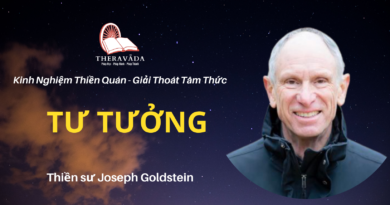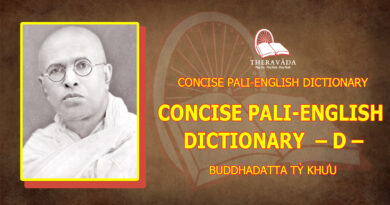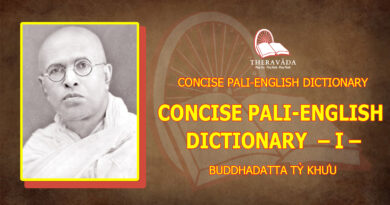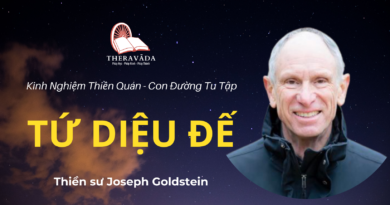Discourse On The Dhammadāyāda Sutta – Phần 5 – Pride And Heedlessness
MAIN CONTENT
- Phần 5 – Pride and Heedlessness
- Pride and Heedlessness
- Birth, Clan, Youth, and Longevity
- Gain, Honour, Respect, and Deference
- Attendants, Wealth, Beauty, Knowledge, and Intelligence
- Seniority, Alms-gathering, Endurance, and Fame
- Morality, Concentration, Skill, Physical Proportions
- Heedlessness
- Six Kinds of Heedlessness
- Two Ways of Practice
Phần 5 – Pride and Heedlessness
– Pride and Heedlessness
– Birth, Clan, Youth, and Longevity
– Gain, Honour, Respect, and Deference
– Attendants, Wealth, Beauty, Knowledge, and Intelligence
– Seniority, Alms-gathering, Endurance, and Fame
– Morality, Concentration, Skill, Physical Proportions
– Heedlessness
– Six Kinds of Heedlessness
– Two Ways of Practice
Pride and Heedlessness
Now we come to the last pair of defilements mentioned in Venerable Sāriputta’s discourse — pride (mada) and heedlessness (pamāda). According to the Pāḷi text of the Khuddakavatthu vibhaṅga there are twenty-seven kinds of pride. In other words, one may become intoxicated with pride originating in one of twenty seven features.
Birth, Clan, Youth, and Longevity
The first cause of pride is birth (jāti). In India this word refers to the caste system. There are four castes: rulers or nobles, priests, merchants, and manual workers. The rulers and the priests are overwhelmed with pride because of their royal blood or learning and this often makes them blind and irrational like a drunkard or a rutting bull elephant.
Some people may fall prey to pride due to attachment to their clan (gotta), their good health (ārogya), their youthfulness (yobbana), their longevity (jīvita), and so forth. For many people, pride regarding good health or youthfulness is a hindrance to the practice of insight meditation in that it makes them unmindful of the unpredictable nature of death.
Gain, Honour, Respect, and Deference
Again, pride may have its origin in wealth or material gain (lābha). Some people are so overwhelmed with pride in their wealth that they take no interest in the practice of mindfulness. Pride over gifts received from lay followers may make a monk so conceited that he becomes slack in the practice of morality, concentration, and wisdom, that is stressed in Dhammadāyāda Sutta. The gift that a lay follower offers as a mark of special reverence is called “sakkāra.” A monk who receives such an honour and is deeply respected by his followers tends to be vain and conceited. This kind of pride concerns especially eminent monks, abbots, teachers and so forth who often become overly egoistic and haughty because of their authority and leadership.
In the time of the Buddha there was a religious teacher called Sañcaya. He had two disciples, Sāriputta and Moggallāna. After attaining Stream-winning on hearing the teaching of the Buddha, the two young men told their teacher about their intention to join the Saṅgha. They urged him to do likewise and practise the Dhamma. Sañcaya declined, saying that as he had been a teacher for a long time, it would be humiliating for him to become a disciple of another teacher. They told him to think twice about what he should do since many people would rally to the Buddha, leaving him virtually without disciples. Sañcaya then said that the wise were outnumbered by the foolish, so the fools who formed the majority of mankind would come to him while only a few wise men and women would go to the Buddha. He seemed to be well aware of the Buddha’s superiority, but hew was unable to follow the Buddha because of his conceit over leadership. Nowadays too there may be some leaders who cannot stomach the idea of practising the Dhamma under the guidance of another teacher. This is a form of pride that makes it impossible for a person to become the heir of the Dhamma.
Attendants, Wealth, Beauty, Knowledge, and Intelligence
Another five causes of conceit are: 1) having many attendants (parivāra), 2) abundance of property (bhoga), 3) beauty (vaṇṇa), 4) learning (suta), and 5) keen intelligence (paṭibhāna). The first two need no elaboration. The third concerns especially women.
In the lifetime of the Buddha, Khemā, the chief queen of King Bimbisāra was very proud of her beauty. She did not go to see the Buddha because she feared that he would belittle her beauty. However, the king planned her visit to the Bamboo Grove in such a way that she could not avoid seeing the Buddha. Then she was amazed to see a very beautiful girl near the Blessed One. She thought that the Buddha did not look down upon beautiful women, for here was a girl more beautiful than she, attending on the Blessed One. In reality the girl was a phantom created by the Buddha. As the queen looked at the girl, the Buddha exercised his psychic power and made the girl gradually become old, sick, and die. The queen became aware of the seeds of disintegration inherent in her own body, and when the Buddha taught the Dhamma to her, she attained Arahantship. She was later honoured by the Buddha as the leading female disciple distinguished by her great wisdom.
Another woman called Janapadakalyāṇī also did not pay respect to the Buddha because of her conceit regarding her beauty, but at last she too was forced to see the Buddha who led her in the same way to Arahantship. She was known an Nandā Therī and she gained distinction in the practice of jhāna. Formerly she was under the domination of pride as was the beautiful Pabhāvatī in the Kusa Jātaka (Jā 531) who scorned King Kusa.
The other two sources of pride are extensive knowledge and keen intellect. Here, knowledge does not mean insight that results from the practice of meditation, for the meditator who has attained genuine insight will never be conceited. It means only the knowledge of worldly affairs or the knowledge of the Buddha’s teaching that one acquires through learning (sutamayā paññā).
Sharp intellect (paṭibhāna-ñāṇa) is the skill that enables a man to speak or write fluently, and to be adroit in the choice of words that make his speech or writing clear, precise, and effective. By virtue of his sharp intellect, he can argue persuasively and tackle problems promptly. Such wit and resourcefulness may be a cause for pride.
Seniority, Alms-gathering, Endurance, and Fame
The next causes for pride are in the case of monks is seniority (rattaññu), having spent a long time the Saṅgha, and for the lay people seniority in government service. Again, the practice of collecting alms (piṇḍapātika), physical endurance (iriyāpatha) as, for example, the ability to walk for many hours, fame (anavaññāta), and accomplishment (iddhi).
The fourth of these, fame, literally means having attendants but here 1 think it should refer to fame or reputation. Thus a monk may become proud when he gains a reputation as a teacher of the Piṭaka, as a preacher, or as a meditation teacher. Excessive conceit may bedevil a government worker who has attained a high official position. The last cause of pride in this group, attainment (iddhi), doesn’t mean supernormal powers as is usually understood by this term, but any unique accomplishment that may give rise to conceit.
Morality, Concentration, Skill, Physical Proportions
The next five causes of pride are morality (sīla), concentration (jhāna), special knowledge or skill (sippa), height (āroha), and girth (pariṇāha). Pride may have its origin in attachment to morality. Those who are morally pure sometimes speak impertinently to those who are not. However, it is not pride if a man stresses moral purity with good intentions and without any holier-than-thou attitude. Another cause of pride is attainment of access concentration (upacāra samādhi), or attainment concentration (appanā samādhi). A meditator may sometimes attain these states of concentration and speak contemptuously of those who do not. Some may fail to attain access concentration because of lack of sustained effort and it is the duty of meditation teachers to pay special attention to such meditators, but this duty has nothing to do with pride. Those who have attained momentary concentration (vipassanā khaṇika samādhi) are not prone to pride. Nowadays meditators who attain jhāna are rare and cases of excessive conceit or pride arising from attachment to jhāna are virtually non-existent.
On the other hand one may be dominated by pride because of outstanding ability in a traditional branch of learning or an academic field. Physical height that is considered neither too short nor too tall may be a cause of pride. A person may have a well-proportioned body (saṇṭhāna), which implies normal height and weight, or may be free from physical defects (paripūri), and these may also cause pride. Altogether there are twenty-seven causes of pride that stand in the way of spiritual progress. It is no wonder that the practice of insight does not appeal to those who are inflated with vanity over their health, wealth, learning, or leadership. Some believe that their good moral life or their regular use of the beads obviates the need for the practice of mindfulness. However, all these various forms of pride are harmful to spiritual progress so they should be rejected through mindfulness.
Heedlessness
The last evil that we should overcome for progress on the holy path is heedlessness (pamāda). It is described in the Khuddakavatthu vibhaṅga as unmindfulness that leads to loss of self-control in respect of improper acts, improper speech, and improper thoughts. This is the worst and grossest of all the many kinds of heedlessness. Killing, stealing, and illicit sex constitute bodily heedlessness, while lying, slandering, abusing, and frivolous talk mean verbal heedlessness, and it is mental heedlessness to covet another person’s possessions, to hate someone and wish them harm, or to accept false views such as the view denying the law of kamma.
Thus heedlessness leads one to do evil in deeds, speech, and thought. It means giving free rein to the mind instead of restraining it, like unleashing an ox and letting it forage at will. The antidote to heedlessness is strict observance of the moral precepts. The constant practice of concentration wards off heedlessness in thought while the practice of insight means the total extinction of heedlessness in respect of the object noted with every act of noting. Heedlessness is uprooted as the meditator progresses on the Noble Path and proceed from one stage to another. Thus at the stage of Stream-winning the gross, unwholesome heedlessness that leads to flagrant breaches of morality become extinct. Then the path of Non-returning brings about the total extinction of heedlessness that give rise to unwholesome thoughts such as sensual craving and ill-will, while the attainment of Arahantship ensures the extinction of all other heedlessness such as that causing desire for existence. However, the Commentary on the Vattha Sutta of the Majjhimanikāya says that the meditator at the stage of Non-returning overcomes four defilements: ill-will (byāpāda), anger (kodha), malice (upanāha), and heedlessness (pamāda). So according to that Commentary, the defilements that still linger in the Non-returner such as lust for life, pride, ignorance, etc., do not belong to the category of heedlessness. So, to overcome the defilements associated with heedlessness one needs to practise the eightfold path until the attainment of Non-returning.
Heedlessness is lack of self-restraint in regard to the five senses. In other words, it is heedlessness to think of the sense-objects, to crave for, or take delight in them. The Buddha instructed the monks that they should use the four requisites of food, robes, medicine, and dwellings not to gratify the sensual pleasures, but only for the preservation of life. The infallible remedy for heedlessness is the practice of concentration and insight
Heedlessness in the form of indulgence in sensual thoughts is not as coarse as the heedlessness that finds an outlet in the violation of the fundamental moral precepts. The preventative measures against heedlessness in respect of the sense-objects are wise reflection, constant mindfulness, and self-restraint. The best thing to do is to note constantly the mental and physical processes such as rising and falling, etc.
Lack of commitment to the practice of insight is bound to give rise to heedlessness as moral transgressions, sensuous thoughts, restlessness, and wandering thoughts. The meditator cannot be free from heedlessness if he is not diligent, determined, persistent, and steadfast in the practice. It is heedlessness to meditate half-heartedly, to meditate off and on, after long intervals, to relax one’s effort, to give up the practice, or fail to meditate continuously and steadfastly.
Six Kinds of Heedlessness
You will now have some idea about heedlessness, which we may arrange in order of gravity as follows. 1) Heedlessness in its weakest and most subtle form may be identified with occasional wandering thoughts and forgetting to note them. 2) Less subtle is the heedlessness that makes us negligent and lets some sense-objects escape our attention. 3) Worse still is the heedlessness that leads to sensual thoughts. 4) More harmful is the heedlessness that causes us to indulge in sensual pleasure. 5) Still more dangerous is the heedlessness that creates the desire to kill, steal, lie, or do other evils. 6) The worst heedlessness is that which finds expression in doing evil in deeds or speech.
Every Buddhist should try to be free from the last two kinds of heedlessness. The fourth heedlessness should be overcome by bhikkhus and lay disciples who practise insight. Meditators should be always mindful and guard themselves against the third heedlessness — sensual thoughts. If sensual thoughts arise during the practice of mindfulness, they should be promptly noted and rejected. As for those who meditate seriously to attain the path, they should strive until they become free from the first two kinds of heedlessness.
Constant noting of the mental and physical phenomena from moment to moment and the development of insight leads to Stream-winning, which ensures the total extinction of six defilements: ingratitude (makkha), arrogance (paḷāsa), envy (issā), meanness (macchariya), deception (māyā), and hypocrisy (sāṭheyya). At the stage of Non-returning, aversion (vyāpāda), anger (kodha), malice (upahāna), and heedlessness (pamāda) become extinct. Finally, at the stage of Arahantship, covetousness and greed (abhijjhāvisamalobha), impertinence (thambha), vanity (sārambha), conceit (māna), excessive conceit (atimāna), and pride (mada) are uprooted. The total extinction of these sixteen defilements on the attainment of the noble paths is described in the Commentary on the Vattha Sutta of the Majjhimanikāya and other teachings of the Buddha.
According to these Commentaries heedlessness is wholly extinct at the Non-returning stage, but attachment to existence, ignorance, conceit regarding virtues that one really possesses, and other defilements still remain. So the meditator will have to continue the practice of the eightfold path until attaining Arahantship that ensures the total extinction of all defilements. Only then will the meditator or the bhikkhu become the worthy heir of the Dhamma in accordance with the teaching of the Buddha.
The practice of the eightfold path is essential to the elimination of pride and heedlessness. This practice involves the constant introspection of the mind-body process or the five aggregates of grasping (upādānakkhandhā) that arise from every act of seeing, hearing, etc. With the development of right concentration or momentary concentration through such practice, the meditator attains insight into the distinction between the mind that notes and the matter (the sense-object) that is noted, and realises the impermanence of everything. This insight is not ordinary knowledge; it is extraordinary and penetrative. Every moment of such insight means momentary extinction of defilements and eventually there arises the insight relating to the path, and nibbāna is realised.
The bhikkhus who attain such insights and overcome defilements are worthy of praise irrespective of their seniority or status in the Saṅgha. They become the real heirs of the Dhamma. The Buddha’s chief disciple Venerable Sāriputta emphasised the need for the heritage of the Dhamma, but it is difficult to understand how we should inherit the Dhamma in terms of the path, its fruition, and nibbāna if we do not know how to practise the eightfold path in conformity with the teaching in the Dhammacakkappavattana Sutta, Satipaṭṭhāna Sutta, Mahāpadhāna Sutta, etc. However, the practice is clear to us and it is not hard for us to teach it as we have practised insight meditation on the basis of these teachings. Those who follow our instructions faithfully will find the practice really beneficial.
The practice of the eightfold path is like taking good medicine for the treatment of a serious disease. Just as good medicines help us to overcome many kinds of illness, so too the practice of the eightfold path helps us to remove various defilements. First we should practise the preliminary path (pubbabhāga-magga) or the path of insight. This practice is effective only if we note the mental and physical process or aggregates of attachment from moment to moment. Such practice leads to insight into the real nature of mind and matter: their impermanence, unsatisfactoriness, and egolessness. These insights that arise in this way constitute the path of insight such as right view, etc. This is the preliminary path that leads to the noble path. When the path of insight becomes well-established, the noble path arises.
Two Ways of Practice
The Commentary describes two ways of practising the eightfold path. Some meditators practise the samatha-oriented vipassanā while others practise vipassanā-oriented samatha. Some develop access concentration (upacāra samādhi) or attainment concentration (appanā samādhi) before they practise insight. This is tranquillity (samatha). In other words, the practice of the eightfold path has two approaches. 1) The development of the path of insight after one has attained tranquillity, and 2) The practice of insight without first trying to attain tranquillity. Tranquillity means access or attainment concentration, where access concentration is pre-jhānic concentration whereby one develops tranquillity to the point of being free from the hindrances (nīvaraṇa).
For some meditators either of these stages of concentration forms the basis of insight. Insight practice involves developing insight into mind and matter, their cause and effect relationship, their dissolution, impermanence, etc. It finally gives rise to the successive stages of the noble path, by the progressive elimination of the fetters (saṃyojana) and latent defilements up to the final stage of Arahantship with the total extinction of all defilements.
The Commentary also describes the bare insight (suddhavipassanā) practice of the Noble Path. This practice does not presuppose either access or absorption concentration, but is concerned with the contemplation of the aggregates or mental and physical process in terms of their characteristics of impermanence and so forth. The contemplation leads to various stages of insight knowledge such as insight into the distinction between mind and matter. This means the Purification of View (diṭṭhivisuddhi), which usually arises from Purification of Mind (cittavisuddhi). However, Purification of Mind presupposes freedom from the hindrances, so although this insight practice bypasses the two kinds of tranquillity, it is based on what is called momentary concentration for insight (vipassanā khaṇika samādhi). Although the meditator may dispense with the two kinds of tranquillity concentration, he cannot do so with momentary concentration, which is absolutely essential to insight practice.
The Commentary refers to the one-pointedness of mind that results from attention to the relevant sense-objects. Here the relevant objects mean the psycho-physical phenomenon that form the objects of insight contemplation. Insight practice rules out external objects that have nothing to do with insight into impermanence, unsatisfactoriness, and not-self, that lead to reflection and discursive thinking.
With the development of concentration, the meditator finds that the mind stops wandering. The noting mind and the noted object become perfectly attuned. There is no consciousness that escapes the meditator’s attention. The mind becomes a succession of noting consciousness. The noted objects vary, but they are in tune with the noting consciousness. At such moments the hindrances become totally extinct and there tranquillity arises, which is called momentary concentration for insight (vipassanā khaṇika samādhi). On the basis of this concentration or Purification of Mind ( citta visuddhi) that arises from it, the practice of mindfulness gradually leads to insight into analytical knowledge of body and mind (nāmarūpapariccheda-ñāṇa), then knowledge of conditionality (paccayapariggaha-ñāṇa). Later, insight develops into the arising and passing away of all phenomena (udayabbaya-ñāṇa) together with their impermanence, etc.
This way of practice begins with the contemplation of mind and matter in terms of their characteristics. Therefore, in this practice insight arises first and tranquillity or momentary concentration (khaṇika samādhi) follows in its wake. In other words, in this practice insight takes precedence over tranquillity.
It is barely possible to overemphasize the importance of insight practice. It is only insight practice that will lead to the attainment of the Noble Path, its fruition, and nibbāna, which makes us real heirs of the Dhamma.









